Monday, September 28, 2009
35: Picadillo
1/4 cup oil
1 onion, chopped
1 green pepper, chopped
1 garlic clove, minced
1/2 lb. ground beef (80/20)
1/2 lb. ground prok
1/2 lb. ground ham
3/4 cup capers
1 teaspoon salt
1/8 teaspoon black pepper
1/2 cup tomato sauce
1/4 cup dry white wine
1. Heat the oil and fry the onion, garlic and green pepper, until softened.
2. Add the three meats and cook until they just start to cook through.
3. Add the remaining ingredients and cook, covered, for 20 minutes on medium heat.
Makes 6 servings.
Pumpkin Soup and Picadillo, Too
Getting to picadillo was a treat. My husband and I usually make some sort of ground turkey rendition that sometimes leans towards picadillo and other times leans towards chili without beans when we add cumin. But this was the time to really make picadillo, the Cuban way, and it was surprising to learn all the ingredients that went into it – not just one type of ground meat.
Since I had decided to do this on a weeknight, I wanted to keep things simple, but because I was already going for it, I threw in a vegetable cream soup to get another recipe in. Happy to report, that even though there were three items I made on a weeknight (killer white rice, of course, with the picadillo was the third dish), we were eating by eight o’clock. Later than I wanted for my kids, but good enough since it was a fully home cooked meal.
Recipe #9: Sopa de Calabaza a la Crema
Now that October was right around the corner, I had wanted to kick off the orange-themed season right. Luckily, the next soup in the creamy vegetable soups part of the soups chapter was for creamy pumpkin soup.
I had bought a bag of frozen pumpkin on a recent trip to the grocery store, so I had that on hand for the dish. Taking the basic recipe for cream of vegetable soup and adding the desired vegetable is the routine for seven recipes.
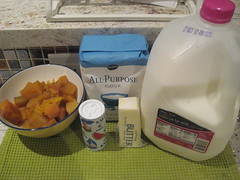
The basic recipe calls for:
3 T butter
4 t flour
2 cups milk
1 t salt
1 cup of the desired vegetable, cooked and mashed
Once you melt the butter over low heat in a caldero or large pot, you put the flour, milk and salt in a bowl and hand blend it until it’s well mixed, without flour lumps. You pour that mix into the pot with the melted butter and you let it heat through, still over low heat. You can be adventurous and play with the heat if you’re standing there because the more heat you put into it, the faster it thickens. But, there’s a fine line between thickening it and burning it, so leave it over low heat if you want to play it safe, stir every so often in-between prepping for your next dish, and once you feel resistance with your whisk or spoon, go ahead and pour in the cooked and mashed vegetable (pumpkin, in this case).
Once you pour in the mashed pumpkin, since it’s still warm from being just cooked, it will heat through with the rest of the liquid and you’re done. Leave the soup covered, on simmer, serve it when ready.

This recipe was ok. It wasn’t a fancy creamy pumpkin very orange soup you’ll get at a trendy restaurant or from a Food Network recipe. I had something else in mind going into the recipe and when I tasted it, it wasn’t what I was expecting. Not to say it wasn’t good, but you have to know going into it, that you’re making a vianda (vegetable) type of soup.
I had taken some leftovers to work and when one co-worker started feeling under the weather, she had some for lunch and it hit the spot and gave her a lift. Maybe this is one of those Cuban-remedies type of foods?
Whatever it is – two creamy vegetable soups down, five more to go!
Beef, pork and ham – those are the three types of ground meat that Nitza’s picadillo calls for. You definitely have to plan ahead, even if just a little, to get this one started. I have these meats in my freezer now because of The Project, but before, you’d only find frozen ground turkey on a regular basis.
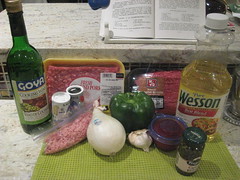
I searched through the recipe and didn’t find raisins. I particularly don’t prefer raisins in my picadillo, but when I saw alcaparrado (capers) in there instead, I was intrigued. After heating some vegetable oil and sofriendo some onion, garlic and green pepper in it, we were ready for the triple-meat combo. You mix the ground meats in with the sofrito and you stir it all well so it doesn’t stick to the pot.

Once the meat is good and cooked, you add in the capers, salt, pepper, tomato sauce and vino seco (dry white wine). Stir it up and leave it over medium heat for twenty minutes.
I did have to call up for help on a doubt I had: to lid or not to lid?

After posting this question on Facebook, I had a slew of friends weighing in:
Armando says, "Depends on how dry you want it. If you go "topless," make sure to turn down the heat a little or you'll risk drying it out too much."
Maritere says, "I always lower the heat and cover it for at least 15 minutes. Seems to absorb more of the flavor that way. If still too liquid at the end, then I raise the temp again for a few minutes with the lid off to allow some of the liquid to evaporate."
I went with the lid on for the full 20 minutes and it was absolute perfection. The next question is – picadillo on top of the rice, or picadillo side by side with the rice. The debate could go on forever!
Monday, September 21, 2009
32: Bistec a la Plancha (Cuban Palomilla Steak)
1 lb palomilla, cut into three steaks
1 sour orange
2 Tablespoons butter
2 garlic cloves
1 onion
1. Marinade the steaks with the sour orange, garlic and onions at least one hour in the refrigerator. Even better if you can marinade it overnight.
2. Melt the butter in a skillet over high heat.
3. Brown the steaks on both sides in the butter.
4. Sprinkle salt on each side of the steaks and continue cooking to your preferred doneness.
5. Remove the steaks and without cleaning the skillet, add the onions and remaining marinade to the skillet.
6. Cook through until the onions are golden and tender.
Serve steaks with cooked onions on top, or as a side dish. Steaks can also be served with raw, chopped onions and parsley on top.
Bistec a la Plancha (Cuban Palomilla Steak)
The first recipe in the 50-recipe beef chapter is good ol' Bistec a la Plancha, otherwise known as Cuban steak. At least I think that's what it is.
Recipe #50: Bistec a la Plancha
Once I sat down to prepare for this recipe (remember, no on the fly cooking with Nitza as she's always throwing curve balls at the end of her recipes), I read through the ingredients and made my grocery list. Easy enough - one pound palomilla steak, naranja agria (sour orange), butter, garlic and an onion.
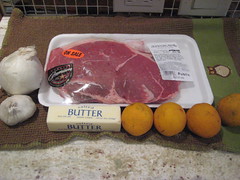
I've never been good with identifying cuts of beef. T-bone, NY strip, flank, skirt, ribeye. To me, if it has chimichurri sauce on it, it's churrasco and if it's thin, it's palomilla. If I need help past that, I consult my beef dictionary (aka my husband) that knows how to describe cuts of beef in my language. And if it's the smallest cut on the menu and says "petit", I go with it because at two points per ounce (for Weight Watchers POINTS), I need the most petite there is.
It wasn't until I had gotten home from Publix that I realized that (a) the recipe didn't call for palomilla, but rather filete del centro, whatever that is, and, (b) the palomilla steak I had bought was the wrong cut.
It was thick! Who does that? If it says palomilla on the outside, why would they put a thick-cut steak in there?
I figured that if I butterflied the steak, I'd make it thin enough, but since I had never really butterflied a steak and only heard about people asking for that to be done to their thick steaks, I didn't know what I was getting myself into.
I took my knife and tried to slice my way into making palomilla cut-like steak. It worked, but I ended up with some small steaks and some ripped pieces of meat and a couple of decent thin steaks. What a mess.
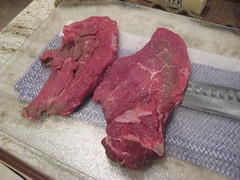
It would have been much easier to just make sure I had the thin steaks I needed before leaving Publix. New note to self: check steak cuts and ask dumb questions from the butcher to make sure you're taking home what you need.
The rest was easy. I drenched the steaks with the naranja agria and covered them with chopped garlic and onions. Left them in the fridge while I prepared to bake some left over french fries from a fancy French restaurant (blasphemy! gasp!) and set the table.
It was a Monday night, folks. Not much time for anything but reheating side dishes.
Melted the butter over high heat and when the pan was screaming hot, I placed the steaks in, two by two. The marinade, as well as the onions and garlic would caramelize and the outside of the steaks would turn a golden brown. It was tough to get the inside cooked through because all the cuts of meat were so varied, but as I got to the last cuts, I had done much better than the mostly bloody rare first ones I had cooked.

All in all, easy recipe that doesn't require much prep work, except for having one pound of thin steak ready and maybe chopping up the garlic and onion the night before. I've heard that actually marinating the palomilla with the naranja agria overnight makes the steak tough, so don't super-prep and just marinate it for one hour, or for as long as you can without stopping progress in your kitchen.
Oh, and what to do with the onions, garlic and juices left in the container you marinated everything in? By adding a little more butter to the pan and mixing it in with the stuff left behind by the steaks, tip in the container and some chopped parsley and you've got certifiable cebollitas for the topping on your steaks.
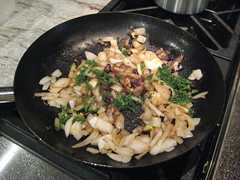
A crowd pleaser, that's for sure, and instant Cuban house smell. What more can you ask for?
An accurate labeling for the cuts of steak, is what I'd ask for, but after this process is done, I'll be speaking carnicero (butcher) language in no time.

